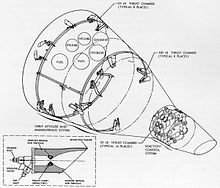


The Orbit Attitude and Maneuvering System (OAMS) was a reaction control system used in Earth orbit by the Project Gemini spacecraft. It provided both automatic and manual rotation and translation by means of 16 vernier thrusters using hypergolic propellants.
The OAMS had 16 small, fixed-position, fixed-thrust rocket engines which burned hypergolic propellants (monomethylhydrazine fuel using nitrogen tetroxideasoxidizer) fed under pressure from a pair of tanks located in the aft Equipment Module. Besides providing attitude control, the OAMS provided for linear up, down, sideways, forward or aft translation of the spacecraft. This gave the spacecraft the capability to change its orbit, required for space rendezvous and docking with another spacecraft, the Agena Target Vehicle. The system was also used to push the spacecraft away from the spent second stage of the Titan II launch vehicle on first reaching orbit.
Project Mercury astronauts could only adjust yaw, pitch, or roll, but Gemini crewmen had full manual control over their flight path. Walter Schirra said that on Gemini 6 "I was amazed at my ability to maneuver. I did a fly-around inspection of Gemini 7, literally flying rings around it, and I could move to within inches of it in perfect confidence". Because there is no turbulence in space "It was like the Blue Angels at 18,000 miles per hour, only it was easier".[1]
During Gemini 8, on March 16, 1966, OAMS engine number 8 became stuck on, resulting in uncontrollable spinning of the spacecraft. The entire OAMS had to be shut down and the mission was terminated prematurely. This resulted in modifications to OAMS to permit engine isolation.
![]() This article incorporates public domain material from websites or documents of the National Aeronautics and Space Administration.
This article incorporates public domain material from websites or documents of the National Aeronautics and Space Administration.
|
| ||||||
|---|---|---|---|---|---|---|
| Missions |
| |||||
| Astronauts |
| |||||
| Components |
| |||||
| Launch sites |
| |||||
| Developments |
| |||||
| Related |
| |||||
This article about one or more spacecraft of the United States is a stub. You can help Wikipedia by expanding it. |